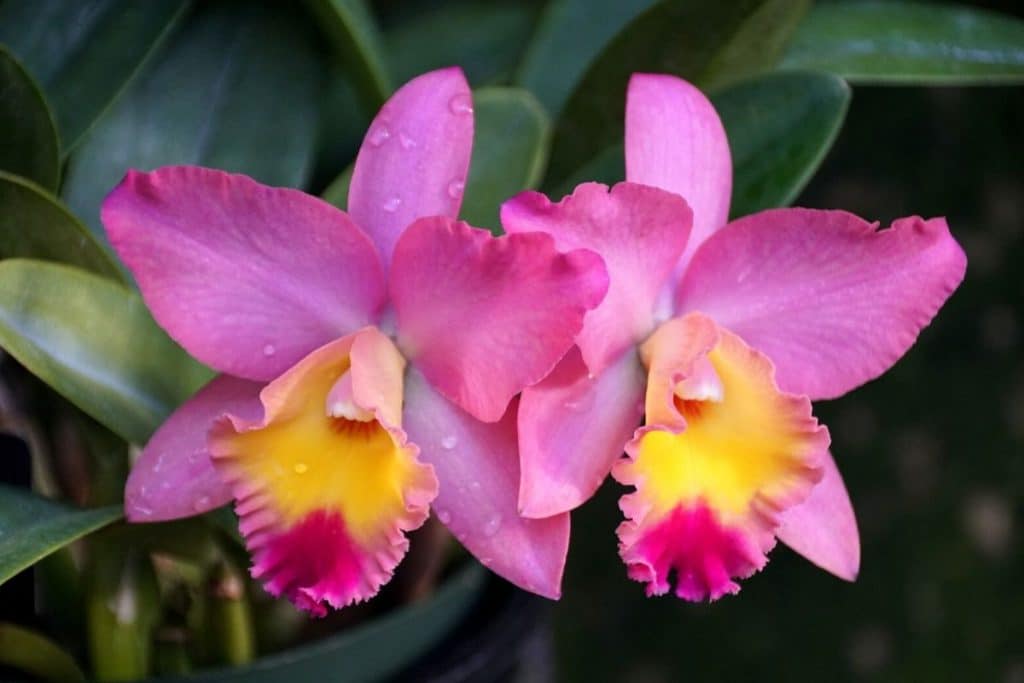Cattleya, or also called corsage orchids and Queen of the Orchids, is one of the most popular types of orchids. For most people, the word orchid is almost always synonymous with cattleyas – that’s how popular this orchid type is than the others.
Cattleya orchids flaunt a stunning appearance that many plant enthusiasts couldn’t resist. The flowers are fragrant, large, showy, and come in a plethora of colors and color patterns. Small-flowered cattleya cultivars also exist in varying forms and spectacular colors.
The Genus Cattleya
Cattleya has showy and fragrant large colorful flowers. It’s one of the most attractive types of orchids you can grow. Here’s what you want to know about this genus.
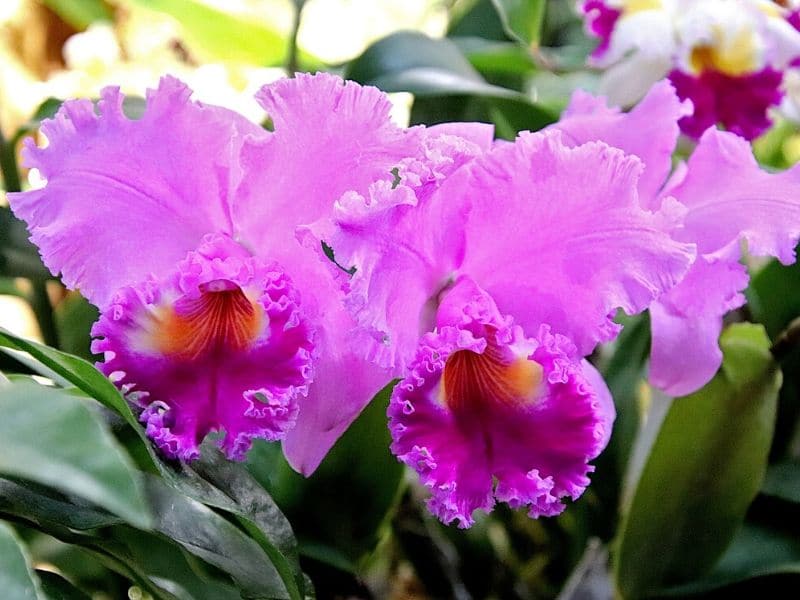
History and Naming of the Genus
The name cattleya refers to an entire genus of Cattleya spp. in the Orchidaceae family.
Plant collector and horticulturist William Cattley accidentally brought the famed “corsage orchid” (Cattleya labiata) to England in 1818 when he imported a bunch of tropical plants from Brazil through wildlife expert William Swainson. It first showcased its beautiful flowers in 1818.
In 1821, plant taxonomist John Lindley described the orchid in one of his books and gave it the name “cattleya” after William Cattley (1).
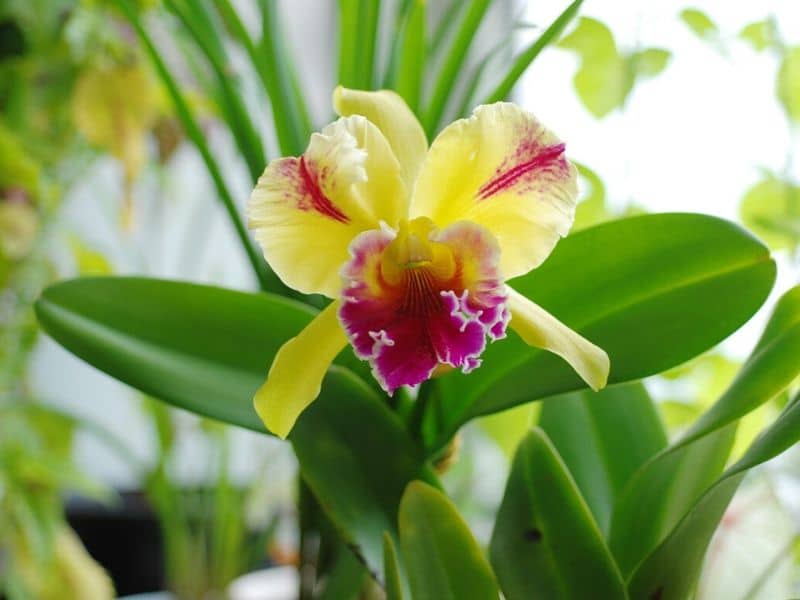
Characteristics of Cattleya Orchids
Cattleya orchids are recognized for their showy and fragrant blooms that exhibit various forms and striking colors. Though some cultivars have smaller flowers, these remained as attractive as their large-flowered counterparts.
These plants are slow growers. They typically take four to seven years to mature when grown by seeds. A mature plant typically reaches about 2 feet tall.
Cattleya Flowers
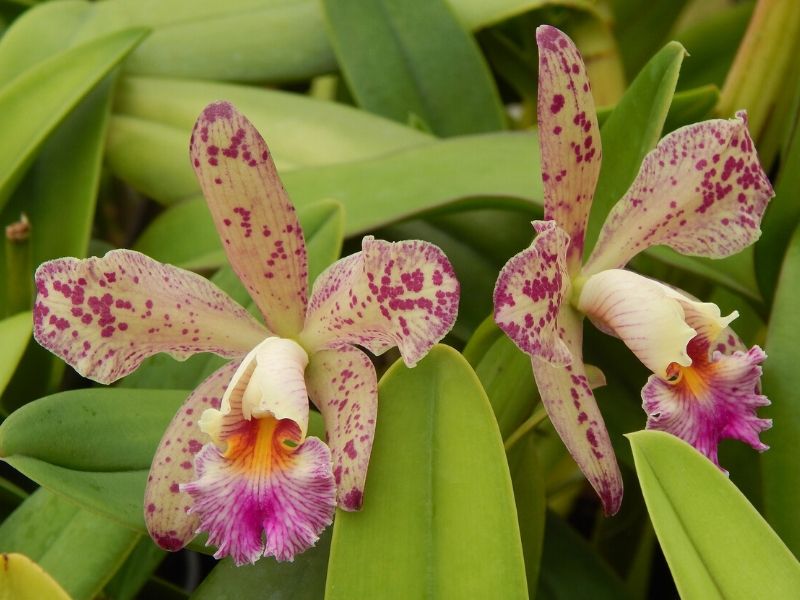
A cattleya flower displays three sepals that enclose two fringed petals and the lip or labellum. The lip, located at the base of the flower, is often decorated with markings or spots (1).
Above the lip is the column that houses the flower’s reproductive parts. The sepals have three simple structures: two of them are similar and points downward, while the other one points upward (2).
The flower can grow up to 8 inches across with colors varying from white to pink, orange, purple, red, yellow, and blue. Flowering usually occurs once a year, but some hybrids produce flowers more than once yearly.
Rhizomes and Pseudobulbs
Cattleyas are sympodial epiphytes, meaning that they grow on structures, like trees, with a horizontal growth habit. They have rhizomes, which form new shoots for the plant’s growth, and pseudobulbs or thickened stems that not only support the plant’s growth but also store and supply nutrients to the plant (2).
Leaves
Cattleya leaves are a little fleshy and green. The shape can be oblong, lanceolate, or elliptical, and with smooth margins.
Cattleya: The Unifoliate Group and Bifoliate Group

There are two main groups of cattleyas based on their leaves: the unifoliate or labiata group and the bifoliate group. Orchids that are part of the unifoliate group have one leaf per pseudobulb, while those in the bifoliate group have two to four leaves per pseudobulb.
Unifoliate orchids can grow up to 18 inches in height and produce large flowers that measure about 5 to 7 inches across.
Generally, each spike produces no more than four flowers that last for up to 20 days. Bifoliate cattleya orchid species, on the other hand, produce more flowers on a single spike, but the blooms are smaller.
Most Popular Cattleya Species
For the genus Cattleya, there are currently 46 acknowledged species and 35 natural hybrids. These orchids originate from tropical areas, such as Central and South America.
Here are some of the most recognized cattleya species among the many available.
C. labiata
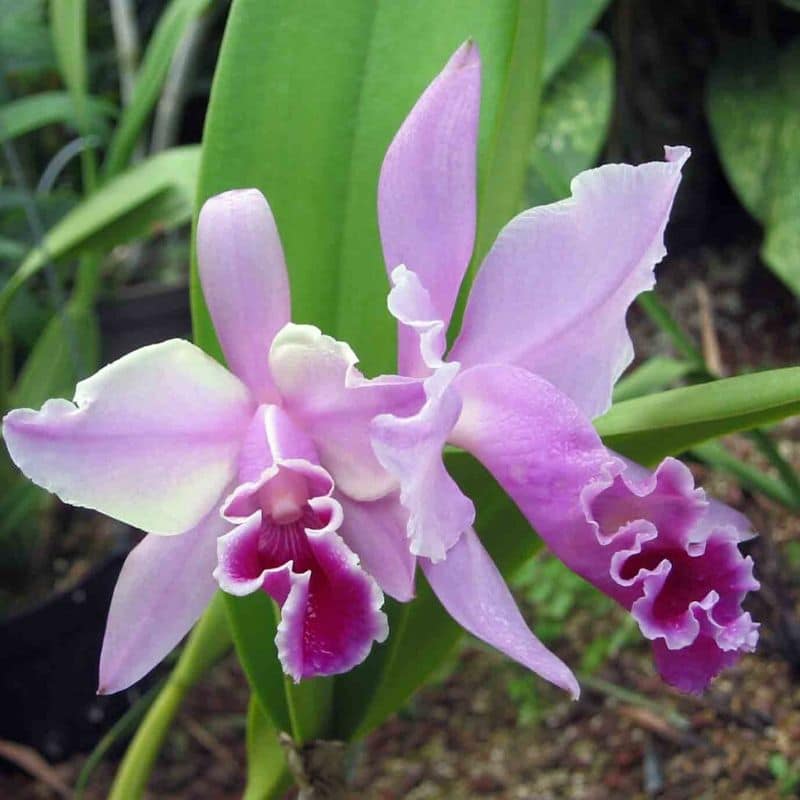
Common name: Crimson Cattleya Orchids, Ruby-lipped Cattleya Orchids
One of the most reliable and easiest cattleya orchids to grow is C. labiata or commonly known as crimson cattleya or ruby-lipped cattleya. Native to Northeast Brazil, these medium-sized orchids grow on trees and rocks in mountain ranges at elevations above 500 meters.
Part of the unifoliate cattleya orchid group, C. labiata flaunts a medium-sized rhizome with club-shaped pseudobulbs under each leaf. Two to five fragrant flowers that grow up to 7 inches across bloom on a single flower spike during fall.
The flowers of crimson cattleya orchids are recognized for their frilled lips and wavy sepals and petals, with colors varying depending on the varieties.
Popular crimson cattleya varieties:
- C.labiata var. semialba
- C.labiata var. tipo
- C. labiata var. coerulea
Cattleya intermedia
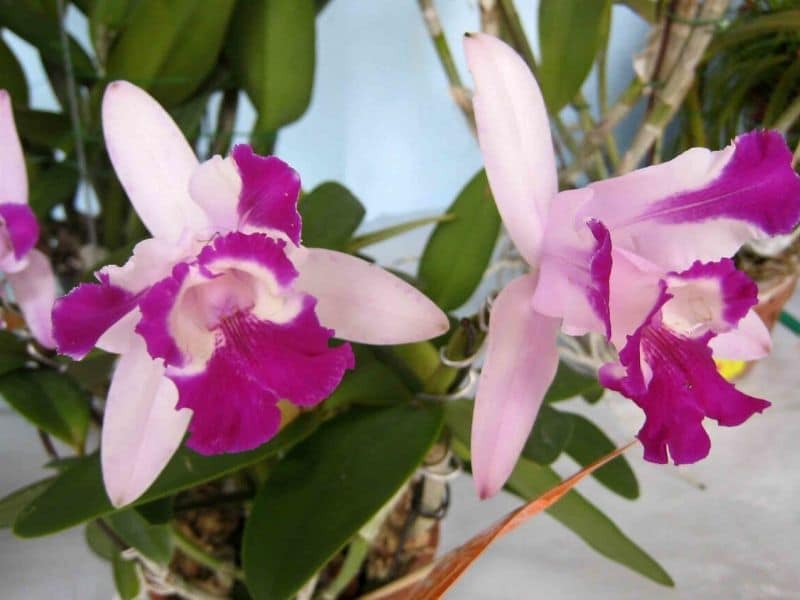
Common name: Intermediate Cattleya Orchid
Cattleya intermedia, or commonly known as intermediate cattleya, belongs in the bifoliate group of cattleya orchids. It is native to central and southern Brazil and grows in coastal parts of Argentina and Uruguay.
This cattleya orchid species is small to medium in size and features short, cylindric pseudobulbs. The flowers are fragrant and typically come in white or pale lavender-pink with a magenta-hued lip.
The petals and sepals can be narrow. Three to seven flowers, which can individually measure up to 5 inches across, bloom in the spring or summer on a terminal flower spike.
Some popular intermediate cattleya varieties include:
- Cattleya intermedia var. alba (pure white with a hint of yellow on the lip)
- Cattleya intermedia var. aquinii (splashed petals)
- Cattleya intermedia var. coerulea (blue)
- Cattleya intermedia var. punctatissima (purple)
Cattleya bicolor
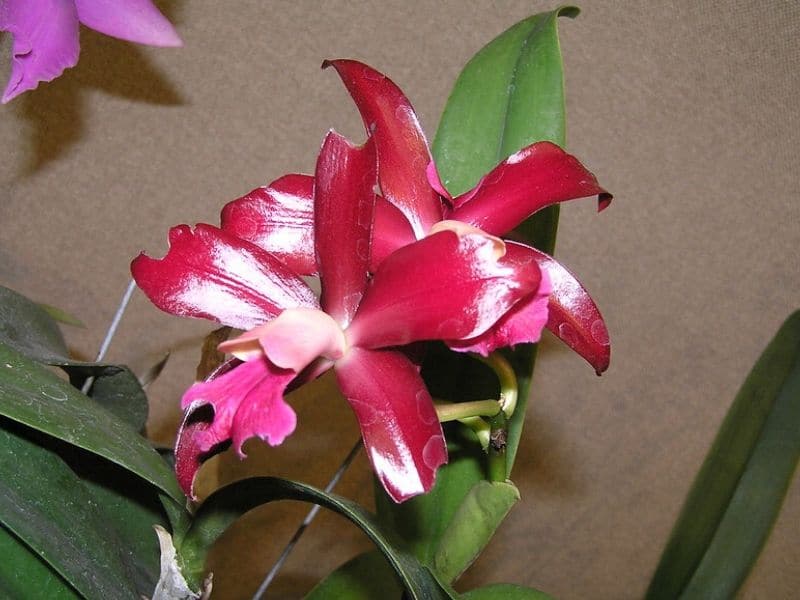
Common name: Bicolored Cattleya Orchid
Introduced in 1836, Cattleya bicolor, or commonly known as bicolored cattleya, is an orchid species that grows in trees and rocks near coastal areas in Brazil.
Bicolored cattleyas are medium to large-sized orchids. They feature stems that grow about 18 to 30 inches high. The pseudobulbs, which are long, ribbed, and cylindrical, are topped with a duo of oblong-shaped leaves.
The erect inflorescence bears two to five flowers that bloom beautifully in spring to mid-summer and occasionally rebloom in the fall. Each flower measures up to 4 inches across, with a wedge-shaped lip and fleshy sepals and petals. Unlike other cattleyas, bicolored cattleyas lack lateral lobes of the lip.
There are three subspecies of Cattleya bicolor in the wild. These are the C. bicolor spp. bicolor, which are found in Sao Paulo and Rio de Janeiro, the C. bicolor spp. Minasgeraisensis from Minas Gerais, and the C. bicolor spp. brasiliensis from Central Brazil, Minas Gerais, Goias, and District Federal.
Bicolored cattleya varieties:
- Cattleya bicolor var. grossii
- Cattleya bicolor var. brazilensis
- Cattleya bicolor var. crassifolia
- Cattleya bicolor var. coerulea
- Cattleya bicolor var. canastrensis
Cattleya aurea
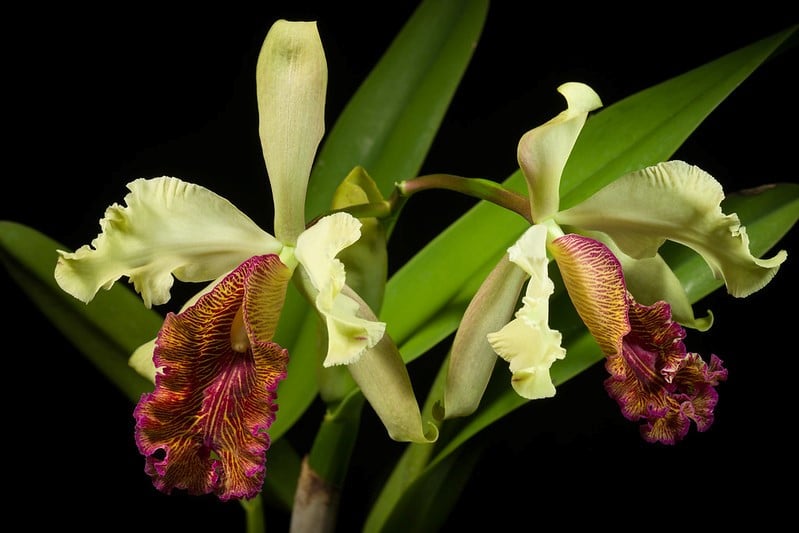
Common name: Golden Yellow Cattleya Orchid
Golden Yellow Cattleya (Cattleya aurea) are medium-sized orchids native to Columbia, where they grow on trees at high elevations.
Like other unifoliate cattleyas such as C. labiata, this orchid displays upright pseudobulbs that bear one green leaf. Matured golden yellow cattleyas usually produce 5 to 6 large flowers that can measure up to 7 inches across.
The exquisite and fragrant flowers are yellow and distinguished for their marked broad lip. They bloom in spring and are short-lived.
Cattleya Hybrids

Cattleya orchid species have been hybridized many times, resulting in a wide range of hybrids. There are two general types of cattleya hybrids: interspecific hybrids and intergeneric hybrids.
Hybridization of cattleyas that occur between species within the same genus refers to inter-specific hybrids. Intergeneric hybrids, on the other hand, refer to cattleya orchid species inter-crossed with other genera.
Examples of this include Cattleya x Laelia or Laeliocattleya, Cattleya x Epidendrum or Epidcattleya, Cattleya x Brassavola x Laelia or Brassolaeliacattleya, Cattleya x Brassavola x Laelia x Sophronites or Potinara, and Cattleya x Brassavola x Laelia x Dialaelia or Iwanagara.
Growing Cattleya Orchids: General Care and Maintenance

Before you get a glimpse of their exotic blooms, you have to put a little effort and patience when growing cattleya orchids. This popular orchid type requires proper growing media, well-draining containers (ideally orchid pots if you can find them), and favorable environmental conditions.
Light: Cattleya orchids will grow well and produce attractive flowers if placed in an area where it can have a fair amount of light but not under direct sunlight. Exposing the plant to intense light will result in the yellowing of leaves. Dark green leaves, on the other hand, may indicate that the plant is not getting enough light.
Temperature: Keep your cattleyas in an area with a day temperature between 70-85˚F and a night temperature between 55-60˚F.
Water: Allow cattleyas to dry out thoroughly before watering since overwatering usually result in extreme damage to orchids like root rot and molds (1). Ideally, watering should be made in the mornings to allow the roots to dry before nightfall. Humidity is key, so you may want to use cool mist humidifiers to make sure your orchids don’t stay completely dry.
Growing Medium and Fertilizer: Cattleya orchids require a well-drained mixture, such as coarse to medium coarse fir bark or tree bark chips and peat moss. Apply a high nitrogen fertilizer every other week during the plant’s active growth.
Repotting: It’s best to repot cattleya orchids every two to three years.
A Few More Tips for Growing Plants in the Cattleya Genus
Cattleya orchids are among the most popular orchid species, mainly because they produce the iconic and vibrant corsage orchid, which is frequently used in tropical-themed events such as weddings. Native to Costa Rica, cattleya orchids thrive in USDA zones 11 and 12 and can be grown indoors or outdoors, as long as certain factors affecting their growth are considered.
One of the primary things to keep in mind when growing cattleya orchids is that they require partial shade or indirect light, particularly in hot climates where direct sun or too much light can scorch the leaves and inhibit the plant’s blooming process. Conversely, too little light can also cause problems and lead to reduced growth and fewer flowers. To ensure optimal growth, cattleyas should be placed in areas receiving early morning sun or those with east-facing windows or behind sheer curtains when exposed to direct sunlight.
Cattleya orchids require good air circulation, high humidity, and temperatures of around 70°F (21°C) during the day and 50°F (10°C) at night throughout the year.
During the growing season, which runs from late fall through late winter, growers should fertilize the plants with a balanced fertilizer at quarter strength to promote healthy blooms, new growth, and prevent stunted development. Good quality potting media such as coconut husk chips, sphagnum moss, tree fern fiber, or clay pellets should be used every two years to promote new root and shoot growth.
A Few More Final Caveats
While cattleya orchids are relatively easy to grow, they are also vulnerable to pests such as spider mites, which thrive in dry, low humidity environments and can cause damage to leaf tips and create brown spots. To combat spider mites, growers can use neem oil, rubbing alcohol, or simply wash the plant with warm water.
Your plants should be checked regularly for other issues such as fungal or bacterial infections, which can occur when the plant is overwatered or has poor drainage.
When repotting cattleya orchids, the new pot should be only slightly larger than the current one, and the plant should be at the same depth as before. This helps prevent overwatering and allows the new potting medium to provide the right amount of water and oxygen to the roots.
As long as proper care is given, cattleya orchids can thrive year-round and produce beautiful and true blue flowers that accentuate any garden or home. Give them a try today!
References
Reference list
- Tuinstra, S., n.d. Cattleya Orchids. [online] Ndsu.edu. Available at: <https://www.ndsu.edu/pubweb/chiwonlee/plsc211/student%20papers/articles08/SandraTuinstra/stuinstra.html>
- Ferry, R., 2005. Orchid Genera–Part I, The Cattleya-Type. [online] The McAllen International Orchid Society Journal. Available at: <http://miosjournal.org/journal/2005/02/OrchidGeneraI.html>
Close
*Featured photo by khairil77/depositphotos

